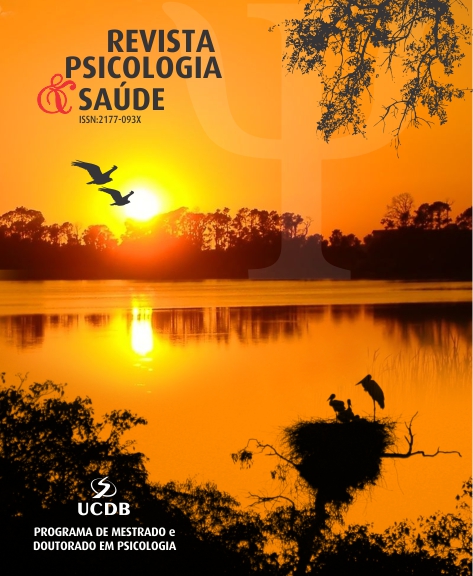Professional and Maternal Perspectives in Autism Spectrum Disorder: Paradigms and Mental Health Care
DOI:
https://doi.org/10.20435/pssa.v15i1.2476Keywords:
family relationships, professional-family relationships, Autism Spectrum DisorderAbstract
Introduction: Autism Spectrum Disorder is a neurodevelopmental disorder, with some approaches focusing on rehabilitation while others emphasize mental health support and psychosocial care. This article aims to understand the perceptions of autism Spectrum Disorder and family relationships of children with the disorder, within the frameworks of psychiatric and psychosocial paradigms, from the perspective of healthcare professionals and mothers. Method: Participants were associated with the Child and Adolescent Psychosocial Care Center in Campo Grande, MS, including four healthcare professionals and three mothers. A qualitative approach with a descriptive and cross-sectional focus was employed. A questionnaire was administered to the healthcare team, and interviews were conducted with the mothers. Results: The results, analyzed through Thematic Content Analysis, revealed perspectives on the challenges posed by the disorder, influenced by challenging behaviors such as nervous breakdowns, feeding difficulties, and sleep disturbances in children. Simultaneously, viewpoints emerged that highlighted the potential strengths of the disorder, particularly in emotional relationships and personal transformations. Discussions and Final Considerations: Stresses the need to promote transdisciplinary articulations in the instrumentalization of health services in order to privilege the potential of the child on the autism spectrum, overcome prejudices and contribute to holistic practices.
References
Almeida, M. L., & Neves, A. S. (2020). A popularização diagnóstica do autismo: Uma falsa epidemia? Psicologia Ciência e Profissão, 40, 1–12. https://doi.org/10.1590/1982-3703003180896
American Psychiatric Association. (2013). Diagnostic and statistical manual of mental disorders (5ª ed.). American Psychiatric Publishing. https://doi.org/10.1176/appi.books.9780890425596
Anjos, B. B., & Morais, N. A. (2021). As experiências de famílias com filhos autistas: Uma revisão integrativa da literatura. Ciências Psicológicas, 5(1), 1–21. https://doi.org/10.22235/cp.v15i1.2347
Bakke, K. A. Autism or autisms? (2022). Autisme eller autismer? Tidsskrift for den Norske laegeforening: Tidsskrift for praktisk medicin, ny raekke, 142(5), 1–3. https://doi.org/10.4045/tidsskr.22.0162
Bardin, L. (2011). Análise de conteúdo. Edições 70.
Cadoná, E., & Scarparo, H. (2015). Construcionismo Social na Atenção Básica: Uma revisão integrativa. Ciência e Saúde Coletiva, 20(9), 2721–2730. http://cienciaesaudecoletiva.com.br/artigos/construcionismo-social-na-atencao-basica-uma-revisao-integrativa/15071?id=15071
Dantas, K. O, Neves, R. F, Ribeiro, K. S. Q. S., Brito, G. E. G. de, & Batista, M. C. (2019). Repercussões do nascimento e do cuidado de crianças com deficiência múltipla na família: Uma metassíntese qualitativa. Cadernos de Saúde Pública, 35(6), 1–19. https://doi.org/10.1590/0102-311X00157918
Dias, C. C. V, Maciel, S. C, Silva, J. V. C, & Menezes, T. S. B. (2021). Representações sociais sobre o autismo elaboradas por estudantes universitários. Psico-USF, 26(4), 631–43. https://doi.org/10.1590/1413-82712021260403
Fadda, G. M., & Cury, V. E. (2019). A experiência de mães e pais no relacionamento com o filho diagnosticado com autismo. Psicologia: Teoria e Pesquisa, 35, 1–9. https://doi.org/10.1590/0102.3772e35nspe2
Kakooza-Mwesige, A., Bakare, M., Gaddour, N., & Juneja, M. (2021). The need to improve autism services in lower-resource settings. The Lancet, 399, 2017–220. https://doi.org/10.1016/S0140-6736(21)02658-1
Leandro, J. A, & Lopes, B. A. (2018). Cartas de mães e pais de autistas ao Jornal do Brasil na década de 1980. Interface (Botucatu), 22(64), 153–163. http://dx.doi.org/10.1590/1807-57622016.0140
Lopes, B. A. (2020). Autismo, Narrativas Maternas e Ativismo dos Anos 1970 a 2008. Revista Brasileira de Educação Especial, 26(3), 511–526. https://www.scielo.br/j/rbee/a/HsffYBhHfB8SrnfgRV9ZScD/?lang=pt
Lord, C., Charman, T., Havdahl, A., Carbone, P., Anagnostou, E., Boyd, B.; Carr, T., Vries, P. J., Dissanayake, C., Divan, G., Freitag, C. M., Gotelli, M. M., Kasari, C., Knapp, M., Mundy, P., Plank, A., Scahill, L., Servili, C., Shattuck, P., . . . McCauley, J. B. (2021). The Lancet Commission on the future of care and clinical research in autismo. The Lancet, 399, 271–334. https://pubmed.ncbi.nlm.nih.gov/34883054/
Ministério da Saúde. (2021). Secretaria de Atenção Primária à Saúde. Linha de cuidado transtorno do espectro do autismo (TEA) na criança. https://linhasdecuidado.saude.gov.br/portal/transtorno-do-espectro-autista/
Menezes, C., & Guanaes-Lorenzi, C. (2016). Sentidos de família construídos com profissionais de saúde na Estratégia Saúde da Família. Athenea Digital, 16(3), 4001–421. https://doi.org/10.5565/rev/athenea.2013
Moura, B. R., Amorim, M. de F., Reis, A. O. A., & Matsukura, T. S. (2022). Da crise psiquiátrica à crise psicossocial: Noções presentes nos Centros de Atenção Psicossocial Infantojuvenis. Cadernos de Saúde Pública, 38(11), 1–12. https://doi.org/10.1590/0102-311XPT087522
Morris, R., Greenblatt, A., & Saini, M. (2019). Healthcare providers' experiences with autism: A scoping review. Journal of Autism and Developmental Disorders, 49(6), 2374–2388. https://doi.org/10.1007/s10803-019-03912-6
National Institute for Health and Care Excellence (NICE) (2021). Autism spectrum disorder in under 19s: support and management (CG170). Clinical Guideline, 1–39. www.nice.org.uk/guidance/cg170
Nunes, D., Schmidt, C., & Nunes, F. de P., Sobrinho (2021). Autism spectrum disorder (ASD): From public policies to evidence-based practices. Education Policy Analysis Archives, 29(77), 1–20. https://doi.org/10.14507/epaa.29.5993
Oliveira, B. D. C, Feldman, C., Couto, M. C. V., & Lima, R. C. (2017). Políticas para o autismo no Brasil: entre a atenção psicossocial e a reabilitação. Physis, 27(3), 707–26. https://doi.org/10.1590/S0103-73312017000300017
Ortega, F. (2009). Deficiência, autismo e neurodiversidade. Ciência e Saúde Coletiva, 14(1), 67–77. https://doi.org/10.1590/S1413-81232009000100012
Pereira, M. L., Bordini, D., & Zappitelli, M. C. (2017). Relatos de mães de crianças com transtorno do espectro autista em uma abordagem grupal. Cadernos de Pós-Graduação em Distúrbios do Desenvolvimento, 17(2), 56–64. https://dx.doi.org/10.5935/cadernosdisturbios.v17n2p56-64
Rios, C., & Camargo, K. R. (2019). Especialismo, especificidade e identidade: As controvérsias em torno do autismo no SUS. Ciências e Saúde Coletiva, 24(3), 1111–1120. https://doi.org/10.1590/1413-81232018243.07862017
Silva, L. S., & Furtado, L. A. R. (2019). O sujeito autista na Rede SUS: (Im)Possibilidade de cuidado. Fractal Revista de Psicologia, 31(2), 119–129. https://doi.org/10.22409/1984-0292/v31i2/5635
Van Tongerloo, M. A., Van Wijngaarden, P. P, Van der Gaag, R. J., & Lagro-Janssen A. L. (2015). Raising a child with an Autism Spectrum Disorder: 'If this were a partner relationship, I would have quit ages ago'. Family Practice, 32(1) 88–93. https://doi.org/10.1093/fampra/cmu076
Vilani, M. R., & Port, I. F. (2018). Neurociências e psicanálise: Dialogando sobre o autismo. Estilos da Clínica, 23(1), 130–151. http://dx.doi.org/10.11606/issn.1981-1624.v23i1p130-151
World Health Organization. International Classification of Diseases for Mortalily and Morbidity Statistics ICD-11. (2022). Eleventh Revision. WHO. http://id.who.int/icd/entity/437815624
Wuo, A. S., Yaedu, F. B., & Wayszceyk, S. (2019). Déficit ou diferença? Um estudo sobre o autismo em pesquisas educacionais. Revista de Educação Especial, 32, 1–21. https://periodicos.ufsm.br/educacaoespecial/article/view/38975
Published
How to Cite
Issue
Section
License

This work is licensed under a Creative Commons Attribution 4.0 International License.
The articles published on journal Psicologia e Saúde holds the copyrights of all texts published by it. Due to that, there is a demand for a letter of copyright cession (see Appreciation). The full reproduction of any article of this Journal in other publications, by any means, requires a written authorization of the Editorial Board. Partial reproductions of articles (abstracts, more than 500 words of text, tables, pictures and other illustrations, sound files) should have the written permission of the Editorial Board and the Authors.












